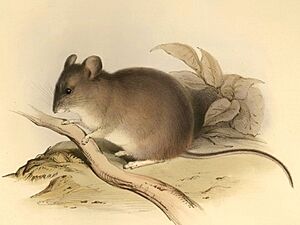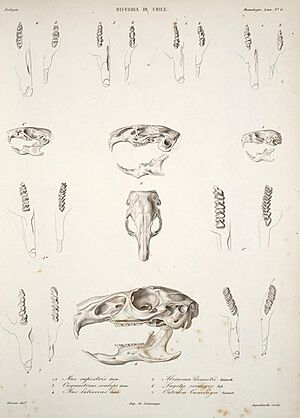Yellow-rumped leaf-eared mouse facts for kids
Quick facts for kids Yellow-rumped leaf-eared mouse |
|
|---|---|
 |
|
| Conservation status | |
| Scientific classification | |
| Genus: |
Phyllotis
|
| Species: |
xanthopygus
|
The yellow-rumped leaf-eared mouse (Phyllotis xanthopygus), also called the Patagonian leaf-eared mouse, is a type of rodent. It belongs to the family Cricetidae, which includes many New World rats and mice. This mouse is the most common kind in its group, the Phyllotis genus.
Contents
What Does the Yellow-Rumped Leaf-Eared Mouse Look Like?
The yellow-rumped leaf-eared mouse is mostly greyish-brown or sand-colored. When it's fully grown, it weighs about 55 grams. Its fur is thick and usually lighter on its belly. This lighter belly helps it blend in with its surroundings. This is called countershading and helps small animals hide from predators.
Just like its name suggests, this mouse has wide, triangular ears. These ears look like leaves, similar to other mice in the Phyllotis group.
The mouse's fur color can change with the seasons. This helps it stay hidden in different environments. Blending in with plants and rocks is very important. Its main predators are raptors, especially owls. Owls hunt by spotting their prey from the sky. These mice are most active at night. This is because it's harder for predators to see them in the dark.
Adult yellow-rumped leaf-eared mice are quite large for their kind. They weigh about 55 grams. Their big ears are usually around 27 millimeters long. Their throat and chin are a light tan color. Their fur is long and soft, with yellowish-brown hairs. Some of these hairs have black tips.
Where Do Yellow-Rumped Leaf-Eared Mice Live?
The yellow-rumped leaf-eared mouse lives in South America. You can find it in the Andes mountains. It lives in Peru, Argentina, Chile, and Bolivia. These mice can live from sea level up to 5,000 meters high. The rocky areas of the Andes offer good places to hide from predators.
However, there isn't much food at very high altitudes. This means the mice can only have babies during the warmer months. The highest place a yellow-rumped leaf-eared mouse was ever found was on top of Volcán Llullaillaco. This mountain is 6,739 meters high. This is the highest altitude any mammal has ever been found living in nature!
Living in cold, high places means these mice have a special way to stay warm. They can change how their bodies produce heat without shivering. This helps them deal with low temperatures. This ability relies on a special type of fat called brown adipose tissue. This adaptation is very important for small mammals like this mouse. It helps them warm up quickly when they wake from a deep sleep called torpor.
What Do Yellow-Rumped Leaf-Eared Mice Eat?
Mice in the family Cricetidae are known for eating many different things. The yellow-rumped leaf-eared mouse eats plants, insects, seeds, and fruits. This varied diet helps them be "opportunistic feeders." This means they can quickly eat whatever food they find. This is helpful when they are in open areas where they might be seen by predators.
Their teeth are special to help them eat different foods. They have large incisors (front teeth). These are separated from their back teeth, called cheekteeth, by a gap. Their teeth grow continuously throughout their lives. This makes their incisors look like tiny chisels. This is because they wear down quickly from rubbing against each other.
A study looked at how these mice changed their behavior based on light. Researchers found that the mice foraged (looked for food) the most in very dark areas. This shows that they try to avoid predators by finding food when it's dark. These mice can also quickly make their bodies warmer in cold places. They have a fast metabolism and use special heat production. This helps them get used to different seasonal climates. To avoid being caught, these mice tend to run away from large shadows. They are less scared of small shadows, like those from small raptors. Also, male mice have been seen going out to find food earlier than females.
Images for kids




